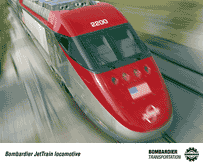Quebec - Windsor Corridor Jet Train, Canada

The Quebec-Windsor Corridor is the most densely populated section of Canada; the term is particularly used in connection with VIA Rail passenger train services, analogously to Northeast Corridor on Amtrak. The principal rail routes within the corridor are:
Quebec City - Montreal (services to the south shore opposite Quebec City are not considered Corridor trains)
Montreal - Ottawa
Montreal - Brockville - Kingston - Belleville - Toronto
Ottawa - Brockville - Kingston - Belleville - Toronto
Toronto - Aldershot - St. Catharines - Niagara Falls, Ontario (with a joint VIA/Amtrak service, the Maple Leaf, continuing Buffalo - Albany - New York)
Toronto - Aldershot - Brantford - London - Windsor, Ontario
Toronto - Guelph - Kitchener - London - Sarnia (with a joint VIA/Amtrak service, The International, continuing Flint - Battle Creek - Chicago)
(Aldershot station is in Burlington, but also serves passengers for Hamilton.)
For the most part these are all operated as independent routes, but a few trains continue beyond Toronto (not to the next main destination, but services such as Ottawa-Aldershot) or cross between the two routes running west from Toronto through London.
Services vary from two trains a day on routes such as Toronto - Niagara Falls up to a maximum of six day trains and one overnight train on the Montreal-Toronto run, much of which is also shared by Ottawa-Toronto trains. As well as the most frequent long-distance train service in Canada, this route is also the fastest, with services operated by Bombardier LRC trains at up to 100 mph.
Several plans have been proposed over the years for the creation of a High-speed rail line in this corridor. Some of the most recent ones are based on a variation of the Acela trains developed by Bombardier for Amtrak while others are based on the new JetTrain prototype turbine locomotive also developed by Bombardier.
Canada’s Bombardier Inc. roll out - in Washington - a jet engine-powered locomotive that has been quietly developing for years in partnership with the U.S. Federal Railroad Administration.
Bombardier believes its 240-kilometres-an-hour JetTrain is the answer to providing high-speed rail service throughout North America using existing track and without the prohibitive cost of electrifying rail networks.
It calls JetTrain the first high-speed, non-electric locomotive designed for the North American market.
It uses a turbine engine to generate power, instead of the diesel engine used in nearly all locomotives in North America for the past 40 years.
Spokesman Warren Flatau of the Railroad Administration said the agency has invested $13 million US in developing the turbine-powered locomotive since about 1997. With Bombardier matching that, JetTrain has cost at least $41 million Cdn so far.
Flatau said JetTrain is just one of several initiatives under that governments and private companies have been exploring as a solution to growing highway congestion in several inter-city corridors in the United States and Canada.
He said the Railroad Administration can’t endorse a commercial product "but Bombardier is the company that stepped up to the plate when we put out the word we were interested in doing this project. We believe that the project holds great potential for bringing about the high speed services that people across the country are expressing a desire for."
Flatau said Bombardier and Amtrak are next going to show off the train at various sites where authorities are pushing for high-speed, inter-city service.
He said he doesn’t know if it will travel to Canada. Via Rail has just handed in a report requested by Transport Minister David Collenette on how to speed up rail service in the Quebec City-Windsor corridor. Via’s best trains reach 150 km/h where track quality permits.
However, as Bombardier Transportation executives show off the 21-metre-long prototype to authorities at Washington’s Union Station on Tuesday, Amtrak officials could be excused for a certain skepticism.
Amtrak and Bombardier are in a nasty legal battle over the trouble-plagued Acela Express high-speed electric train recently introduced on the northeast corridor linking Boston, New York and Washington.
There has been a rash of train delays and breakdowns with Acela, the first high-speed train service in North America. Amtrak ordered 18 from Bombardier and its French partner Alstom, and 15 have been delivered.
Although the train is popular thanks to its speed and comfort, Amtrak has vowed never to buy another.
The JetTrain locomotive develops 5,000 horsepower, with about half the weight of some current diesel freight locomotives. Flatau also said it’s quiet and has "rather remarkable acceleration capabilities."
Ross Capon, executive director of the National Association of Railroad Passengers, said he is not aware of any non-electric locomotive in service that can reach 240 km/h.
Capon said the big question for JetTrain’s market success is how much it costs and how much fuel it requires. "That’s going to be one of the main issues."
It is not the first time a jet turbine has been used to move a train. Jerome Pier, a consultant on the Bombardier design, said there are seven trains operating since 1977 in New York State using jet turbines incorporated into coaches.
Pier, owner of a private consulting group based at Carlisle, Ont., said the "power-car" trains have 3,000 horsepower each, not enough to reach high speeds. He said the JetTrain breaks new ground by its power and speed.
Best known as propulsion engines for jet aircraft, turbines are also adapted to drive backup electrical generators for utilities and to power pipelines.
The JetTrain prototype was assembled at Bombardier’s plant in Plattsburgh, N.Y.
